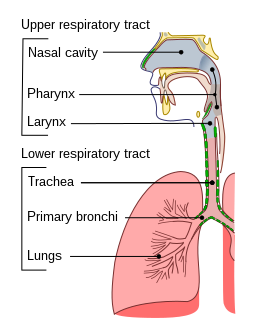HUMAN RESPIRATORY TRACT SYSTEM

Structure
The respiratory tract is divided into the upper airways and lower airways. The upper airways or upper respiratory tract includes the nose and nasal passages, the pharynx, and the portion of the larynx above the vocal cords. The lower airways or lower respiratory tract includes the portion of the larynx below the vocal cords, trachea , bronchi and bronchioles. The lungs can be included in the lower respiratory tract or as separate entity and include the respiratory bronchioles, alveolar ducts, alveolar sacs, and alveoli.
The respiratory tract can also be divided into a conducting zone and a respiratory zone, based on the distinction of transporting gases versus exchanging them.
From the bronchi, the dividing tubes become progressively smaller with an estimated 20 to 23 divisions before ending at an alveolus.
Upper respiratory tract
The upper respiratory tract, can refer to the parts of the respiratory system lying above the sternal angle (outside of the thorax), above the glottis (vocal cords), or above the cricoi cartilage. So that the larynx is sometimes included in the upper airway and sometimes in the lower airway.The larynx is also called the voice box and has the associated cartilage that produces sound. The tract consists of the nasal cavity and paranasal sinuses, the pharynx and sometimes includes the larynx.
Lower respiratory tract
The lower respiratory tract or lower airway is derived from the developing foregut and consists of the trachea, bronchi (primary, secondary and tertiary), bronchioles (including terminal and respiratory), and lungs (including alveoli. It also sometimes includes the larynx.
ALVEOLI
Our bodies perform certain functions every second of the day and night without our conscious awareness. For example, breathing is a job that our body does for us, whether we are asleep or awake, conscious or unconscious. But what is the actual purpose of breathing, other than merely keeping us alive? You probably already know that it has to do with taking in oxygen and getting rid of carbon dioxide. In this lesson, we will learn about tiny organs that help our body parts get the oxygen that we breathe in and get rid of the carbon dioxide we don't need. These organs are called alveoli.
HEART


very nicely done, informative and neat.
ReplyDelete